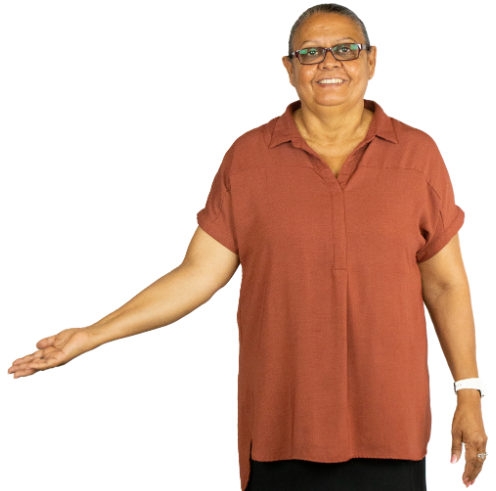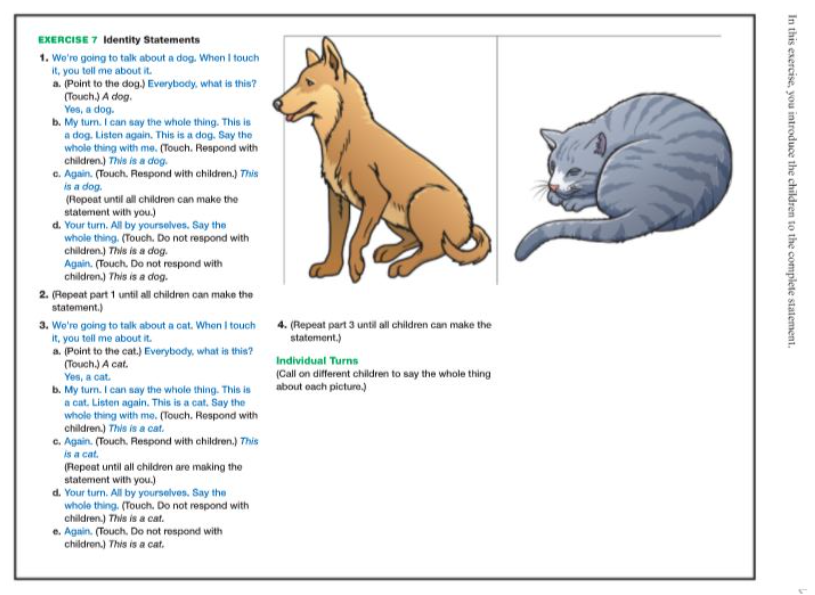Teach Reading Mastery Signature Edition: Language Arts Year K
-
Module introduction5 Topics
-
Overview23 Topics|3 Tests
-
Cover
-
Lesson objective
-
Opening the lesson
-
Direct instruction overview
-
RMSE-LA K overview
-
Teacher’s role in motivation
-
RMSE-LA K materials
-
Time requirements
-
Placement testing
-
Placement testing procedures
-
RMSE-LA K placement test
-
Check your understanding
-
Test your understanding
-
Transition lesson
-
Grouping, seating, STAR, transitions
-
Script features
-
Pacing of instruction
-
Expected lesson pacing
-
Effective transitions
-
Check your understanding
-
Test your understanding
-
Review
-
Lesson completed!
-
Cover
-
Action Formats24 Topics|3 Tests
-
Cover
-
Lesson objective
-
Opening the lesson
-
Organisation of lessons
-
Hand-drop signal
-
Hand drop signal
-
Teaching beginning actions formats
-
Corrections in actions formats
-
Actions statements
-
Corrections in actions statements
-
Individual-turns rationale
-
Steps of individual turns
-
Check your understanding
-
Test your understanding
-
Point-touch signal
-
Point-touch Signal
-
Point-touch signal in actions – pictures formats
-
Actions – pronouns
-
Corrections in actions – pronouns
-
Video in production
-
Check your understanding
-
Test your understanding
-
Review
-
Lesson completed!
-
Cover
-
Object identification, identity statements, yes-or-no questions and ‘not’ statements formats17 Topics|3 Tests
-
Cover
-
Lesson objective
-
Opening the lesson
-
Object identification formats
-
Object identification corrections
-
Video in production
-
Identity statements
-
Identity statements corrections
-
Check your understanding
-
Test your understanding
-
Yes-or-no questions formats
-
Yes-or-no questions with ‘not’ statements corrections
-
Video in production
-
Check your understanding
-
Test your understanding
-
Review
-
Lesson completed!
-
Cover
-
Common Objects and Opposites Formats18 Topics|3 Tests
-
Cover
-
Lesson objective
-
Opening the lesson
-
Common objects
-
Common objects corrections
-
Video in production
-
Check your understanding
-
Test your understanding
-
Opposites – full/ not full
-
Opposites – full/ empty (format)
-
Common errors opposites
-
Later opposites formats
-
Align to Australian english
-
Video in production
-
Check your understanding
-
Test your understanding
-
Review
-
Lesson completed!
-
Cover
-
Descriptions of Objects – Plurals Formats19 Topics|3 Tests
-
Cover
-
Lesson objective
-
Opening the lesson
-
Description of objects – plurals
-
Hand drop signal
-
Pacing
-
Pause and punch
-
Practice
-
RMSE LA K actions-plurals with pause and punch
-
Check your understanding
-
Test your understanding
-
Plurals
-
Plurals and statements
-
Droning and corrections
-
RMSE LA K plurals and statements with corrections and individual turns
-
Check your understanding
-
Test your understanding
-
Review
-
Lesson completed!
-
Cover
-
Information and Background Knowledge20 Topics|3 Tests
-
Cover
-
Lesson objective
-
Opening the lesson
-
Introduction to information and background knowledge
-
Teaching names and school information formats
-
Names and school information corrections
-
RMSE LA K school information with error correction and individual turns
-
Check your understanding
-
Test your understanding
-
Teaching days of the week formats
-
Days of the week corrections
-
Teaching months of the year formats
-
Months of the year corrections
-
Teaching seasons formats
-
Seasons corrections
-
RMSE LA K seasons with error correction
-
Check your understanding
-
Test your understanding
-
Review
-
Lesson completed!
-
Cover
-
Actions - parts of the body, part /whole, and materials formats22 Topics|3 Tests
-
Cover
-
Lesson objective
-
Opening the lesson
-
Introduction to part/ whole
-
Eye contact
-
Actions – parts of the body formats
-
Part/ whole-table formats
-
Part/ whole corrections
-
RMSE LA K Part/whole with error correction
-
Check your understanding
-
Test your understanding
-
Preparing for materials lessons
-
Materials part one formats
-
Materials – part one corrections
-
Materials – demonstration formats
-
Materials part two formats
-
Materials – demonstration corrections
-
RMSE LA K Materials demonstration with error correction and individual turns
-
Check your understanding
-
Test your understanding
-
Review
-
Lesson completed!
-
Cover
-
Common information, actions - first/ next, and prepositions - on and over24 Topics|2 Tests
-
Cover
-
Lesson objective
-
Opening the lesson
-
Common information introduction
-
Common information formats
-
Common information corrections
-
Instructional words and problem-solving concepts introduction.
-
Actions – first, next formats
-
Actions – first, next corrections
-
Actions – first, next workbook exercises
-
Actions – first, next, last formats
-
Actions – first/ next corrections
-
Video 16 RMSE LA K Actions-First, next, last
-
Check your understanding
-
Test your understanding
-
Introduction to prepositions track
-
Prepositions – on demonstration
-
Prepositions – on corrections
-
Prepositions – on/ over formats
-
RMSE LA K Prepositions-On/over with error correction and individual turns
-
Check your understanding
-
Test your understanding
-
Review
-
Lesson completed!
-
Cover
-
Prepositions and 'Same/ Different' Formats24 Topics|3 Tests
-
Cover
-
Lesson objective
-
Opening the lesson
-
Prepositions – in front of
-
Prepositions – in front of corrections
-
Prepositions – in front of, on, over formats
-
Prepositions – in front of, on, over corrections
-
RMSE LA K Prepositions in front of, on, over with corrections and individual turns
-
Check your understanding
-
Test your understanding
-
Actions – and
-
Actions – and corrections
-
Same/different introduction
-
Actions – same
-
Same – picture format
-
Different
-
Same/ different (Class formats)
-
Same/ different (Corrections)
-
Firming student responses
-
RMSE LA K Same – with error correction and individual turnsvidual turns
-
Check your understanding
-
Test your understanding
-
Review
-
Lesson completed!
-
Cover
-
Rules - 'If/ Then, Where, Who, When and What, Classification, and Concept' Application Formats24 Topics|3 Tests
-
Cover
-
Lesson objective
-
Opening the lesson
-
‘If/ then’ rules explained
-
Actions — rules
-
‘If/ then’ actions — corrections
-
Rules —pictures
-
Video in production
-
Where, who, when and what
-
Where, who, when and what questions
-
Where, who, when and what corrections
-
Check your understanding
-
Test your understanding
-
Classification track
-
Classification exercise
-
Classification rule
-
Concept application
-
Concept application format
-
Concept application corrections
-
Video in production
-
Check your understanding
-
Test your understanding
-
Review
-
Lesson completed!
-
Cover
-
Program Assessments and Motivating Students21 Topics|1 Test
-
Cover
-
Lesson objective
-
Opening the lesson
-
Mastery tests
-
Conducting mastery tests
-
Scoring and evaluating the mastery test
-
Mastery test (Criterion)
-
Mastery test (Remedies)
-
Mastery tests on SPT
-
Lesson progress on SPT
-
Engaging students
-
Teacher’s role in motivation
-
STAR rules
-
Teacher-student game
-
Teacher-student game points
-
Specific praise
-
Watch the video
-
Check your understanding
-
Test your understanding
-
Review
-
Lesson completed!
-
Cover
-
Workbook exercise, stories and poems21 Topics|3 Tests
-
Cover
-
Lesson objective
-
Opening the lesson
-
Independent work beginning levels
-
Auditory signal
-
Auditory signal
-
Workbook lesson one
-
Matching and pair relations
-
Temporal first, picture completion and spatial first
-
‘Top/ bottom’, ‘part whole’ and ‘shapes’
-
Concept application, prepositions and locations
-
Same/ different, some, all, none and materials
-
RMSE LK K workbook
-
Check your understanding
-
Test your understanding
-
Work-check beginning levels
-
Stories and Poems
-
Check your understanding
-
Test your understanding
-
Review
-
Lesson completed!
-
Cover
-
Module evaluation survey1 Topic
Participants 556

Identity statements
In Lessons three through thirty-eight, students identify pictured objects with two-word responses, then make Identification statements.
The teacher introduces the statement using model, lead, test.

The Process
The teacher pauses one second after saying, ‘I can say the whole thing’ and ‘Listen again’ to differentiate between instructions and the statements the students will be repeating. The teacher points to the picture and says the whole thing but does not touch it. Students learn that the teacher’s touch is the signal for them to respond.

The process is:
- The teacher says, ‘Everybody, what is this?’ and signals (point-touch).
- The teacher emphasises the word ‘what’ when saying, ‘What is this’?
- The teacher says, ‘Yes, a dog’.
- The teacher says, ‘My turn. I can say the whole thing. This is a dog. Listen again. This is a dog. Say the whole thing with me’. And signals (point-touch).
- The teacher emphasises the words ‘whole thing‘ every time it is said.
- The teacher repeats saying the whole thing with the students and signals (point-touch).
- The teacher says, ‘Your turn. All by yourselves. Say the whole thing’ and signals (point-touch).
- In later exercises the teacher does not model or lead any of the student responses.

Image reproduced courtesy of McGraw Hill Pty Ltd from Reading Mastery Signature Edition Language K Teacher’s Guide, page 41.
Turn to page 41 in ‘RMSE-LA K’ Teacher’s Guide.
Practice teaching lesson 5, exercise 7 with no Student-errors.

